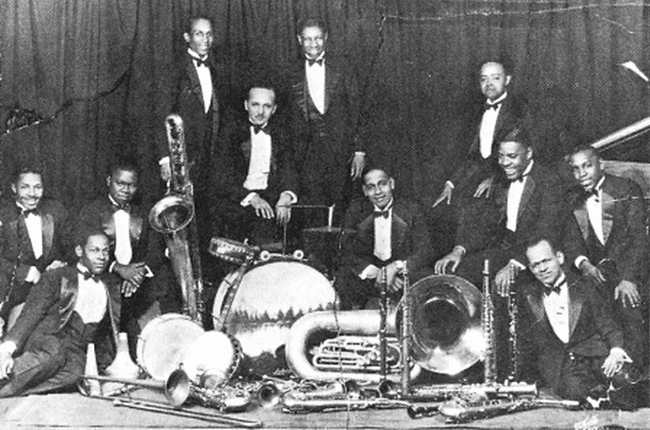Shangai Shuffle
Fletcher Henderson & his Orchestra: Louis Armstrong, Elmer Chambers and Howard Scott (trumpet), Don Redman (alto sax, clarinet, oboe), Buster Bailey (alto sax, clarinet), Coleman Hawkins (tenor sax, clarinet), Charlie Green (trombone), Fletcher Henderson (piano), Charlie Dixon (banjo), Ralph Escudero (tuba) and Kaiser Marshall (drums) (1924).
After three months in drummer Ollie Powers’ band, in late 1924 Louis Armstrong accepted an invitation from Fletcher Henderson to go to New York to play in his orchestra, the top African-American dance band of the time with arrangements by Don Redman, replacing trumpeter Joe Smith. The city was in full artistic bloom and Henderson had landed a contract with his orchestra at the prestigious Roseland Ballroon. Then Armstrong had to switch to trumpet in order to better fit in with the wind section.

Henderson and Redman started to integrate his swinging vocabulary into the arrangements, transforming the ensemble into what is regarded as the first jazz big band. The other members of the group were also gradually influenced by his emotional style, including tenor saxophonist Coleman Hawkins, whose playing changed significantly, and who later became the first major jazz soloist on his instrument. Therefore, Armstrong taught the other musicians how to swing and in turn he learned the new dynamics of the orchestras, which were divided into sections.

Fletcher Henderson behind the drums
Louis Armstrong third from left
Armstrong also made recordings with the main female blues singers of the time, such as Alberta Hunter, Ma Rainey, Trixie Smith and Clara Smith, although the ones he did with Bessie Smith were the most remarkable. He also collaborated on several recordings directed by vocalist, pianist and songwriter Clarence Williams, a King Oliver’s old friend, and in two cuts he coincided with the other musician who stood out above the rest, soprano saxophonist and clarinetist Sidney Bechet. Nevertheless, Armstrong wasn’t comfortable in Henderson’s band: his teammates didn’t have enough discipline, the leader wouldn’t let him sing fearing that his rough vocalizing would be too rude for the sophisticated audience, and when Joe Smith came back he assigned more solos to him, as he preferred his way of playing.



Copenhagen
Fletcher Henderson & his Orchestra: Louis Armstrong, Elmer Chambers and Howard Scott (trumpet), Don Redman (alto sax, clarinet, oboe), Buster Bailey (alto sax, clarinet), Coleman Hawkins (tenor sax, clarinet), Charlie Green (trombone), Fletcher Henderson (piano), Charlie Dixon (banjo), Ralph Escudero (tuba) and Kaiser Marshall (drums) (1924).

The Meanest Kind Of Blues
Fletcher Henderson & his Orchestra: Louis Armstrong, Elmer Chambers and Howard Scott (trumpet), Don Redman (alto sax, clarinet, oboe), Buster Bailey (alto sax, clarinet), Coleman Hawkins (tenor sax, clarinet), Charlie Green (trombone), Fletcher Henderson (piano), Charlie Dixon (banjo), Ralph Escudero (tuba) and Kaiser Marshall (drums) (1924).

Mandy Make Up Your Mind

Everybody Loves My Baby
Fletcher Henderson & his Orchestra: Louis Armstrong (lead trumpet), Elmer Chambers and Howard Scott (trumpet), Don Redman (alto sax, clarinet, oboe), Buster Bailey (alto sax, clarinet), Coleman Hawkins (tenor sax, clarinet), Charlie Green (trombone), Fletcher Henderson (piano), Charlie Dixon (banjo), Ralph Escudero (tuba) and Kaiser Marshall (drums) (1924).

Sugar Foot Stomp
Fletcher Henderson & his Orchestra: Louis Armstrong (cornet), Elmer Chambers and Howard Scott (trumpet), Don Redman (alto sax, clarinet, oboe), Buster Bailey (alto sax, clarinet), Coleman Hawkins (tenor sax, clarinet), Charlie Green (trombone), Fletcher Henderson (piano), Charlie Dixon (banjo), Ralph Escudero (tuba) and Kaiser Marshall (drums) (1925).

Do you want to get involved? Do you want to support music and this project? Follow us to keep you updated and read our Introduction post!